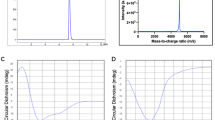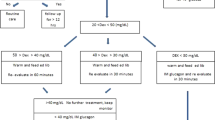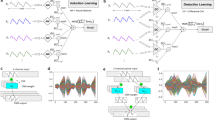Abstract
Four children, treated with diazoxide for idiopathic leucine-sensitive (ILS) hypoglycemia of infancy, had follow-up studies at 2 to 10 yr of age to assess: (1) persistence of leucine sensitivity in later childhood, (2) pancreatic glucagon responses, and (3) the hormonal and glycemic effects of diazoxide therapy. On the third day after diazoxide therapy. was stopped, the mean ± S.E. baseline plasma glucose level (65.3 ± 3.4 mg/dl) was significantly (P < 0.005) lower than that of the controls (80.1 ± 3.1 mg/dl). Corresponding mean plasma immunoreactive insulin (IRI) and immunoreactive glucagon (IRG) values were higher than control values but the differences were not significant. After the oral administration of leucine (50 mg/kg) in the ILS children, the mean plasma IRI level rose from 15.2 ± 4.1 to 59 ± 19 μU/ml, the mean plasma glucose concentration fell to 36.0 ± 3.3 mg/dl and the mean plasma IRI level rose from 196 ± 16 to 261 ± 41 pg/ml. These responses were significantly greater (P < 0.05 to 0.005) than those of control children who received 150 mg/kg of leucine. Intravenous arginine administration caused similar changes in mean plasma glucose, IRI and IRG values in the ILS and control children.
During diazoxide therapy in the ILS children, the baseline mean plasma glucose level (89.5 ± 4.2 mg/dl) was significantly (P > 0.005) higher than without therapy. Corresponding mean plasma IRI and IRG values decreased with therapy but the differences were not significant. Diazoxide therapy blunted the changes induced by leucine administration in the ILS children but did not significantly change their response to arginine infusion.
Our results indicate that marked sensitivity to leucine persists after infancy in the ILS children. Their IRG responses are appropriate to the stimuli, indicating that their pancreatic α cells do not share the abnormality of the β cells. Diazoxide therapy increases baseline plasma glucose levels and inhibits IRI responses to leucine in ILS children, but it has little if any effect on IRG responses.
Speculation: The mechanisms for abnormal insulin response to leucine in patients with ILS hypoglycemia is not known. An abnormal regulation of insulin secretion due to lack of inhibition by somatostatin, is possible and requires investigation. Although pancreatic surgery is usually not indicated, determination of the distribution and hormone content of pancreatic IX, p, and l) cells deserves careful study, should the opportunity arise.
Similar content being viewed by others
Log in or create a free account to read this content
Gain free access to this article, as well as selected content from this journal and more on nature.com
or
Author information
Authors and Affiliations
Rights and permissions
About this article
Cite this article
Roe, T., Kogut, M. Idiopathic Leucine-Sensitive Hypoglycemia Syndrome: Insulin and Glucagon Responses and Effects of Diazoxide. Pediatr Res 16 (Suppl 1), 1–4 (1982). https://doi.org/10.1203/00006450-198201001-00001
Issue date:
DOI: https://doi.org/10.1203/00006450-198201001-00001



